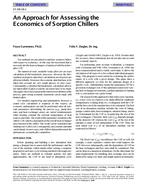Description
Two methods are presented to optimize sorption chillers with respect to economics. To this end, the investment that is necessary for the heat exchangers is balanced with the achievable COP.
The numerical tools available today allow for an exact calculation of thermodynamic processes. However, the thermophysical property data these calculations are based on are often not reliable. Moreover, the economic data that have to be taken into account are very rough guesses in most cases. Consequently, a detailed thermodynamic calculation often is too much effort if quick economic decisions have to be made. This paper shows how, based on the main irreversibilities of the process, quite strong economic statements can be made with limited effort.
For detailed engineering and optimization, however, a sound cycle calculation is required. In this respect, an economic optimization can only be performed when all relevant parameters determining the process (e.g., pump flow rates and heat exchanger areas) are varied simultaneously while keeping constant the external temperatures of heat sources and sinks. The result of this parameter variation is the chiller COP, which is dependent on the overall heat exchanger area invested in the chiller. This result can be translated into running cost vs. first cost. Consequently, an economic optimum can be found. In most cases, only chillers that perform near the optimum are economically competitive.
Units: SI
Citation: Symposium, ASHRAE Transactions, 1998, Vol 104, pt. 1A, San Francisco
Product Details
- Published:
- 1998
- Number of Pages:
- 7
- File Size:
- 1 file , 100 KB
- Product Code(s):
- D-7903




